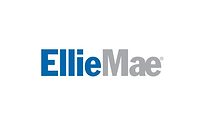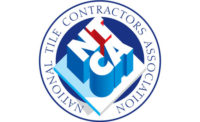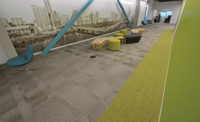Editor’s Note: The following article originally ran in a longer version and under a different headline in TILE magazine’s January/February 2016 issue. For more information about TILE, visit tile-magazine.com.
Over the last several years, distressed looks—which mimic the aesthetic and feel of certain natural materials including wood, stone, cement and concrete—have become some of the most popular items in the market. With the relatively recent introduction of digital inkjet technology, these looks have only continued to evolve, becoming more realistic and convincing. In some cases, it’s even become hard to tell the difference between what’s real and what’s not.
In today’s marketplace, emphasis is being placed on wood-look tiles, according to Alena Capra, owner of Alena Capra Design in East Fort Lauderdale, Fla. “The wood-look is definitely the most popular right now,” she said. “I just did the floors in my new office, and the wood I chose is a distressed-looking, old barn wood. I went to large retailers and everyone is starting to sell that look.
“In general, we’re definitely seeing wood looks pop up that are much more distressed, aged and worn, with a lot of marks and cross-graining. Another big thing that’s happening is a shift of color.”
“I also saw it in Spain when I visited some factories. I saw a lot of reds and blues incorporated into looks of distressed woods. Everything has more of a mix of colors; there are even gray and white engineered woods. There’s also a new ‘mix and match’ trend; that’s real popular right now.”
Emily Holle, creative director of M S International Inc. (MSI), agreed with Capra, explaining how both the color options and the graphics for wood looks have evolved. “Everyone is chasing ‘what is the wood-look you’re supposed to have?’ and I would say a variety. You have to have a beautiful and traditional one that looks like hardwood, a distressed wood, and a more modern, sleek wood look. Wood is still popular and still growing, and I think distressed is still a part of it.
“In general, we’re definitely seeing wood looks pop up that are much more distressed, aged and worn, with a lot of marks and cross-graining. Another big thing that’s happening is a shift of color. Everyone [originally] wanted brown. Now, we see a lot of washes—gray washes, white washes (creamy), etc.—so the variety among color has given some life to the wood trend that we’ve seen for so long. They’ve mastered all shades of brown and espresso, but are now moving into ash tones and lighter tones, which are really nice.”
Capra noted, “When wood looks started, there were a lot of cherry woods and things like that. Now, there are a lot of restored and industrial woods, gray and brown woods, and whitewashed wood looks. Everything I’m seeing now has beautiful gray, taupe tones—much less of a dark, wood look. It’s more about showing the beauty of the wood, and I think that’s because digital printing has gotten so good.”
Regarding the “mix and match” trend, Holle stated, “We have a wood look that you can mix with other looks called Forest Natural. And we also have Capella, which has wood, brick and cotto looks. For me, the wood part of these lines are exactly what I mean by distressed. They’re a great example of what people are looking for, with grain and knots in them, and a slight texture to them on the surface but not super textural.”
Michael Mariutto, president and CEO of Mediterranea, has observed the “mix and match” trend as well, helping create several lines for the company to cater to the growing demand. “Without a doubt inkjet technology has revolutionized the design process for all porcelain tiles—both distressed and more modern looks,” he explained. ”It also gives us the opportunity to offer new hybrid graphics, mixing elements from wood, cement and stone, for example. These hybrid graphics can best be seen in our popular series, Bayside and Urban Stone.”
Distressed Looks Beyond Wood
Mariutto believes people are still drawn to wood- and stone-look tiles, but also sees other distressed looks beginning to take the main stage, including contemporary and rustic brick-look tiles. “Rustic wood looks continue to be in demand, especially in the residential market. However, the last couple of years have seen a surge in rustic brick looks, a trend that started last year with the introduction of Mediterranea’s Chicago series. Rustic brick looks continue to make inroads.”
Holle is also seeing the brick-look grow in popularity. However, Holle doesn’t think these and other trending distressed looks, such as those inspired by concrete and cement, have hit their peak just yet.
“We see them a lot in commercial world, but most of our products end up in residential homes, so I don’t see those looks being as popular. We have a cement look—and I think everyone should have one—but it’s not as mainstream yet. There’s a contemporary swing going on across the U.S.; we’re seeing some pops of this trend in places like the Northeast, metro and urban areas, but it hasn’t hit where it will ultimately for the whole U.S.”
Italian companies such as Monocibec of the Fincibec Group and Ceramiche Brennero are reporting the exact opposite, with cement-inspired looks on the rise. “The ceramic collections with an antique effect or distressed look are part of a wider trend involving the world of interior design,” explained Vittorio Borelli, CEO of Fincibec Group. “Stone-, concrete- and wood-effect porcelain stoneware have been widely used in major projects and commercial spaces, but in private residential projects, where tastes emerge more clearly, there is a greater emphasis on details. To adequately respond to this need, we have proposed innovative collections, such as Monocibec’s Eclipse, which mixes the aesthetics of earthenware and cement with a realistic antique finish.
Anna Ruggi, president at Ceramiche Brennero, echoed Borelli’s comments. “For us, wood and stone looks are still the most popular and best-selling collections, but we are convinced that people desire to find new materials,” she said. “For this reason, we have conceived this line, Terra, which takes inspiration from the colors of nature, and we believe that people will like it, as it interprets the most beloved colors but with a contemporary key.”
Natural Materials Continue to Inspire
Sander Nauenberg, director of sales & marketing at Island Stone North America, has seen two trends coming into the limelight. “The ‘distressed look’ is gaining more mainstream popularity (i.e. wood-look, cement-look, etc.), while the ‘refined look’ is one step ahead,” he explained. “We’re seeing it at the commercial level and in more modern markets. There’s still a huge market for the rustic look; it just has become more mainstream. But in the real cutting edge markets, we’re seeing a liking for really refined looks.”
While Nauenberg is seeing a shift towards natural materials, Capra said it really depends on the location and particular taste of the client, which is what she’s observed from working with clients up and down the East Coast. “In New York City, I don’t do wood tile as much—I do real wood,” she said. “In bathrooms, yes, I do wood-look tile. But, for main flooring, real wood is what it is.
“However, for my market down here in South Florida, I use tile for most of the floors I do. About 90% of my clients choose tile over wood, since it’s not as suitable in our climate. And, when it comes to longevity, it doesn’t scratch or stain.”









